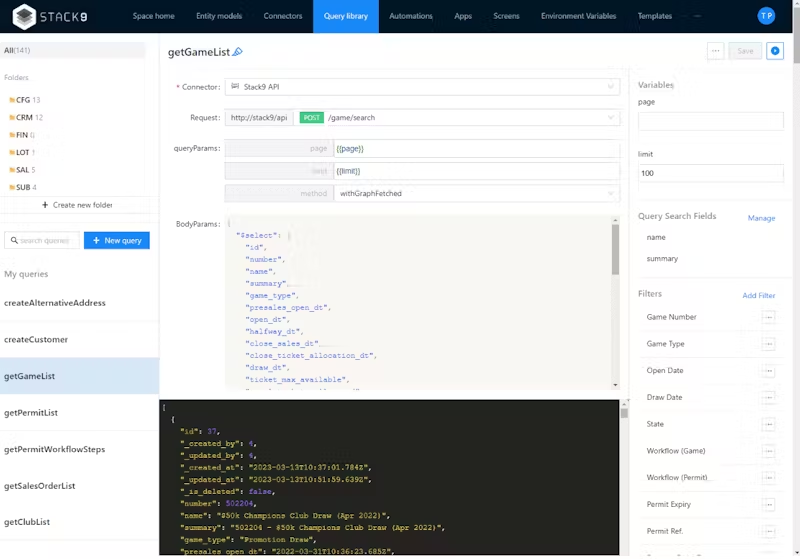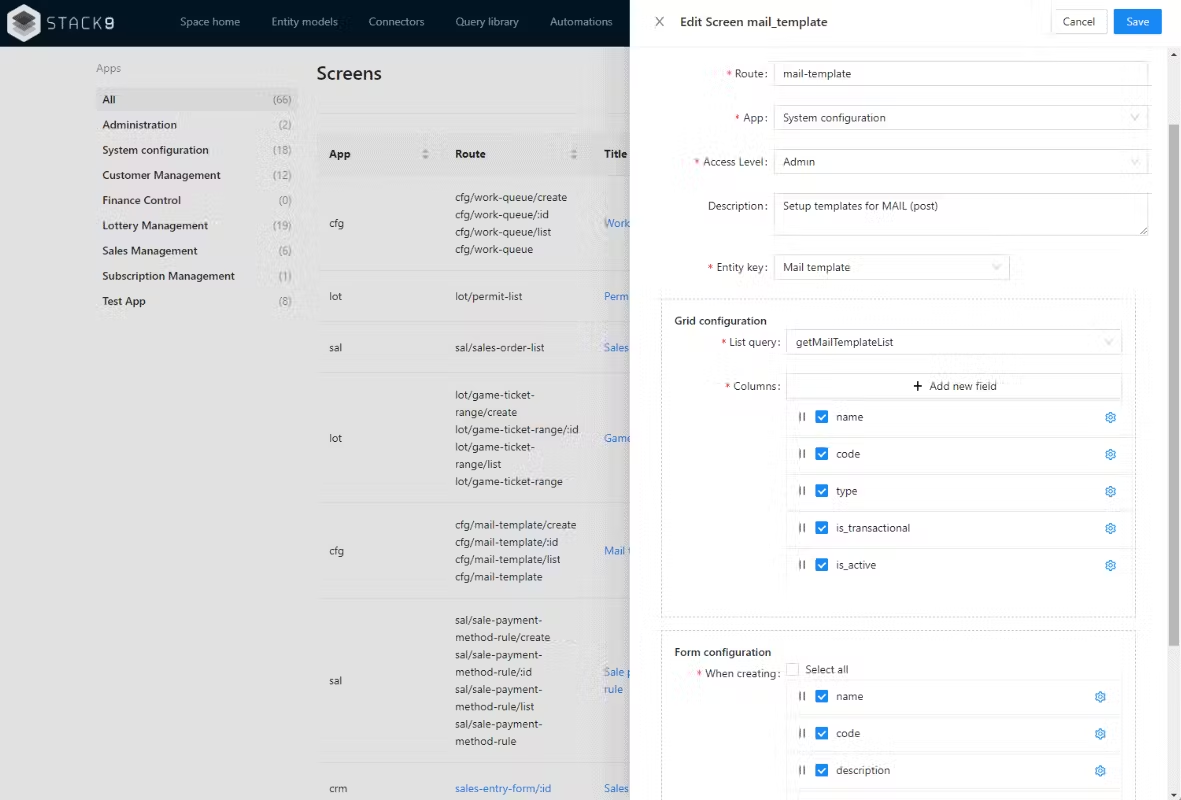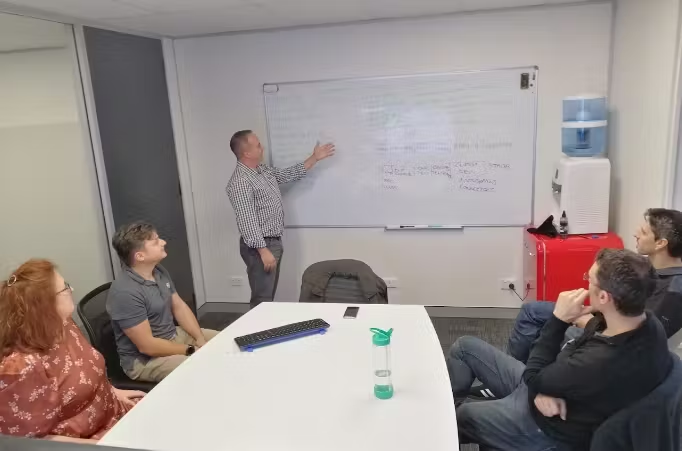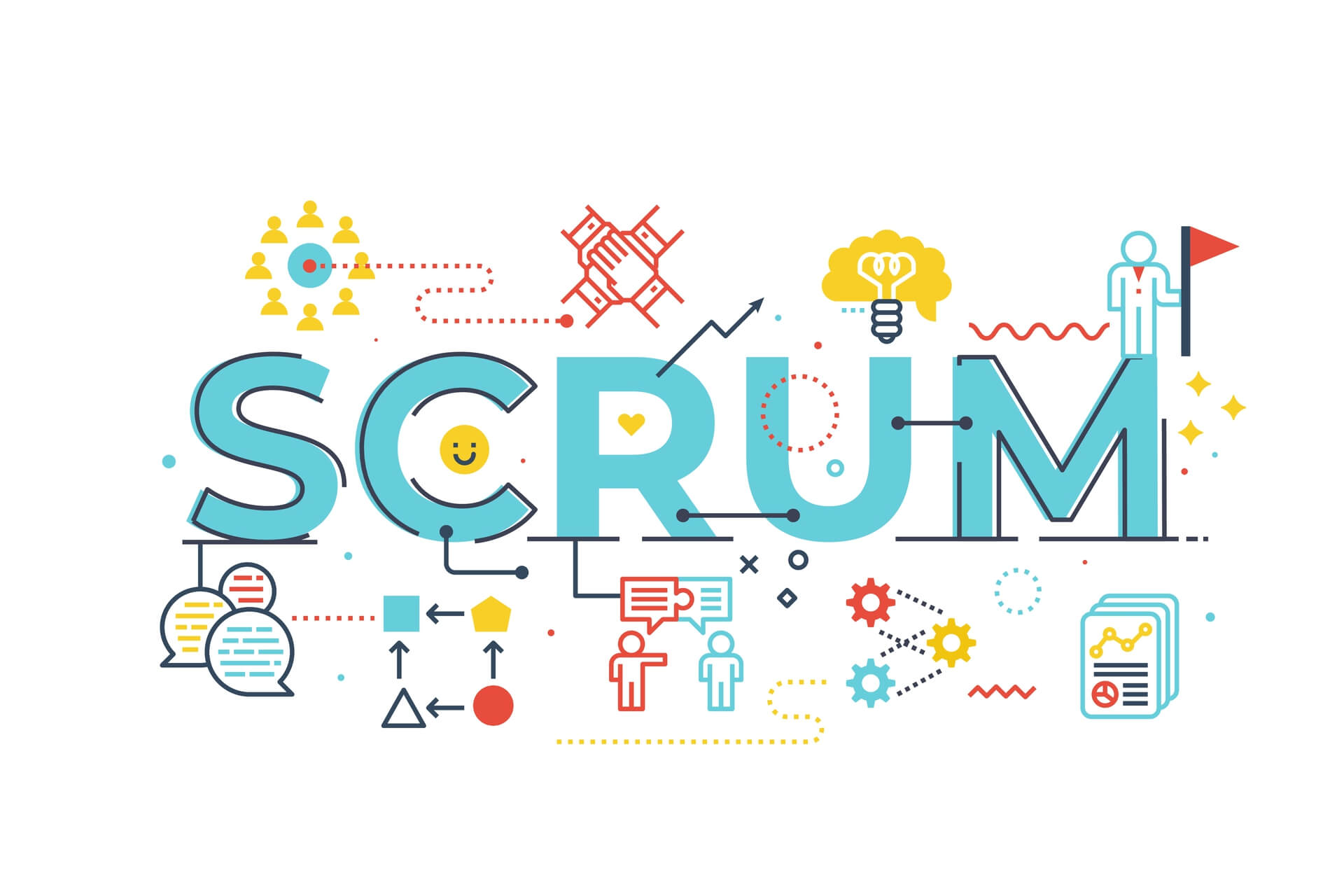Introduction
With a mix of excitement and trepidation, today I sit down to pen a long-awaited article about our very own software-secret-weapon: Stack9. Existing clients and partners of April9 will by now have heard our team (sometimes fanatically) espouse our in-house platform's features and benefits, but even for those who are familiar with Stack9 and what it does, there will be some fresh insights in store.
You see, in 2022 we came to a crossroads with Stack9. It has proved absolutely game-changing for our clients' software development projects, allowing them to build, manage and deploy their applications at a fraction of the cost that traditional development would incur. But as the demand for Stack9 continues to grow, with more and more businesses adopting the platform to power their enterprise apps, and users requesting new features to derive even more business value from it, we started to think about what Stack9 would look like in 5, 10 or even 20 years from now.
In this article we reveal some exclusive behind-the-scenes information and strategic decision-making that took place at April9 this year, and how it's shaping the future of Stack9 as a platform, and by extension, the software development industry in Australia.
What is Stack9?
Now, it's possible you've been living under a rock for the past couple of years and haven't even heard of Stack9. Maybe you clicked this article because of the pretty thumbnail (aww, thanks) or because you're putting off looking at that thorny piece of work that's been sitting on your desk all week. It's okay, I forgive you. Let me get you up to speed.
Stack9 is a low-code rapid-development platform that lets developers, solution architects and power users build, deploy and manage business applications in a secure, cost-effective and reliable way independent of - or in tandem with - traditional software development. If that description was too long or too wordy - or if you bumped into me in the elevator pre-8am on a Monday while I was still nursing my first coffee and asked me what Stack9 was - I would tell you “it's an app that builds apps faster, better and cheaper than you could from scratch”.
Features
Here's what Stack9 DOESN'T do:
Compete with WordPress, Wix and Squarespace as a “low-cost, drag-n-drop website builder”
Let you pump out UI-intensive direct-to-consumer mobile apps and games. Sorry, no shortcut to the next Fruit Ninja here.
However, here's what Stack9 DOES do:
Connect, query and perform operations on relational or NoSQL external databases
Create, store & manage databases using Postgresql, SQLServer, MongoDb
Expose data through REST API endpoints
Handle API integration to unify disparate enterprise applications
Manage fine grain user access permissions
System configuration management using data schemas, JSON files & intelligent integrations
Auto-generate entities and screens using pre configured CRUD functionalities and templated designs
Create internal and public-facing apps, using low-code and other UI elements suitable for both developers and business users
Configure workflows and automate processes based on existing business logic and rules. Trigger actions, move records based on defined criteria, assign to users and automate notifications to accelerate work and reduce admin and delays
Build forms using validation and custom logic - the data capture then integrates directly with your database and business workflows to automate the entire process
Create apps and screens to be publicly accessible or protected by membership for your external users
Develop and design your Stack9 apps, screens and automation using our web-based rapid application development (RAD) online tool
Build powerful email templates and integrate with your existing ESP (or use ours)
Embed MS Power BI, Amazon QuickSight or Tableau dashboards
Automate development, deployment and system update operations from the command-line interface (CLI)
Ensure security by leveraging April9's public cloud (ISO 27001 certified environment)
Pull data into Stack9 and push data out using webhooks
Integrate with external platforms such as AWS or Azure services, email service providers or any REST or SOAP APIs
Create custom actions, triggers and workflows
Build powerful automation pipelines using “chain data”, prebuilt triggers or Node.js traditional development
Run serverless applications using battle-tested Docker containers, maximising performances, cost optimization, security, and reliability
Auto-scale using built-in AWS & Azure cloud services such as load balancers to cater for the most demanding workloads
…and a bunch more things which will make the more technical readers drool, and the rest of us have our eyes glaze over.
Stack9 Low-code integration capabilities

Stack9 Low-code query building capabilities

Stack9 Low-code data management capabilities

Use cases
Stack9 was born from the realisation that, when you boil it all down, most businesses are fundamentally trying to solve the same problems:
“How can we reduce our technical debt?”
“How can we automate this manual process?”
“How can we get these legacy apps to talk to each other?”
“How can we manage compliance more effectively?”
“How can we leverage technology to increase our productivity and overall business agility?”
“Why are we still using [insert your most despised outdated technology here]?!”
Having laboured through decades of “unique/complex/custom/special snowflake” software projects for several decades, the senior staff at April9 had a collective lightbulb moment. Why not, instead of building all of these solutions from scratch every single time, create a collection of universal components that would be a 90% match to each of the most common business use cases, then simply polish the edges to fit the client's business-shaped-problem?
That's exactly what we did, and as a result we've been able to tremendously reduce both the time-to-market and the development costs for our clients over the past few years.
Stack9's use cases are somewhat explained by its features, listed above, but from a more high level view our clients have used Stack9 to build:
Headless Content Management Systems (CMSs)
Agile business applications
Back-office solutions
Workflows & Automations
Secure data management portals
Government e-services
Benefits
The prime benefit of Stack9 is the phenomenal savings in both development time and cost that businesses can enjoy. By building an app with Stack9 some of our clients have saved months of build time and six-figures plus in development costs, thanks to Stack9's core componentry and library of features and functions.
The benefits derived from powering your business applications with Stack9 vary largely on how it's applied - but everything from reducing administrative costs, automating processes, improving cross-departmental communication, improving data accessibility and integrating previously siloed systems, empowering business users, improving data security, eliminating unnecessary delays or facilitating faster execution times on the operational level - the list goes on.
In addition to the aforementioned benefits, Stack9 projects are accompanied by the expert hands and minds of April9's solutions team. As a Partner Organisation rather than a service provider - a distinction important enough to capitalise the term as a proper noun - we work closely with our clients in understanding their business goals, processes and constraints, and ensure the solution design is fit-for-purpose. The IT services industry is - unfortunately - rife with rip'n'run cowboys and highway bandits whose prime concern is in getting paid ASAFP regardless of what the project looks like at handover. At April9, we've carefully cultivated a reputation for quality workmanship and development outcomes that impact our clients' bottom line, and forged relationships that last for years. This is why we're the preferred development partner among many national and multinational organisations and numerous government bodies, handling mission-critical, often security-intensive* IT projects that impact hundreds of thousands of end users. Bottom line? With Stack9 you don't just get an app - you get a partner committed to your success.
* Did we mention the platform is ISO 27001 certified?
Who is Stack9 for?
Stack9 is an enterprise-grade application. This means that its features, technologies and security have been designed to cater for medium-to-large organisations and government bodies, typically with complex processes, multiple user groups and numerous applications powering their operations that might not necessarily be “playing well together”. These are the same clients with which April9 has earned its reputation; we're intimately familiar with how these organisations are structured: their governance, their constraints, their stakeholders and compliance requirements.
Current Stack9 adopters include Surf Life Saving Australia, Gallagher Bassett, the Australian Department of Finance, Eagers Automotive, AUSTREX, to name a few. Stack9 powers business applications in over a dozen industries and between internal and public users facilitates millions of daily transactions and other user-driven activities.
“The key to success with adopting Stack9 is having a subject matter expert with a deep understanding of the business's technical requirements so you can customise the application build to meet your niche needs.”
- Richard Schedler, Senior Business Analyst at April9
The Demand for More
So far so good, right? Unicorns and rainbows for everyone, I hear you say. It's true, Stack9 has been an absolute game-changer both for April9 and for our clients, allowing our clients and our team to bring applications to life faster than ever before. Then something happened that we didn't expect - our clients loved Stack9 so much that they wanted to use it themselves. And I don't mean the apps that Stack9 builds for them - but the Stack9 Rapid Development Platform itself.
We've been incredibly flattered by the numerous, enthusiastic requests from people within our clients' organisations who wanted to get access to a sandbox version of Stack9 to test the platform's capabilities and see what other value they could derive from it.
Here's the thing - Stack9 was never modelled as a direct-to-consumer platform. It's designed as a development tool that superpowers technical & business users to build and manage apps. The UI was never anything flashy like these venture-backed, meteoric, gone-in-a-flash low-code apps you see touted by Silicon Valley moguls and incubators. It's a bare-bones, value-driven, battle-tested business-app builder.
So now we had a bit of an identity crisis on our hands - what was this app? And what could it become?
There was only one way to get to the bottom of this… April9ers, assemble!
Stack9 V4
As with any in-production, supported application, Stack9 undergoes regular updates, patches and feature releases to improve user experience, security and overall functionality. Over the years we've released three major versions of Stack9 - releases that were significant enough to be considered an application-wide upgrade. These version releases have seen continual improvement in the overall usability, appearance and performance of the platform. With Version 4 of Stack9 pencilled in for early-2023 release, we had to assess the platform's future and decide if this was the moment to introduce a public-release version of the platform where end users would download/access Stack9 and build their own app prototypes themselves.
The “crossroads workshops”

Due to the nature of the platform, this was a complex topic (as you'll come to see), and to ensure we had a 360-degree view of all the considerations necessary to make the best step forward, we invited the key players from April9 and Stack9 to table a discussion. The “crossroads workshops” took place over the course of three weeks, and were intended to ultimately steer the course of the v4 Stack9 release including whether or not - and to what extent - the platform would be accessible for “citizen developers” (users with little to no experience using the platform to date, but with great knowledge of their businesses), and the implications that would have on the platform's features, security, pricing, and performance.
Present at these workshops were:
Thiago Passos, CEO at April9
Alfrieda Robertson, Solution Architect at April9
Allan Clempe, Head of Engineering at April9
Richard Schedler, Senior Business Analyst at April9
Darien Palm, Customer Service Operations Manager at April9
David Barzilay, Contract Marketing Officer for Technology Companies
Isaac Alexander, Content Creator Extraordinaire at April9
Together we resolved to right all the world's wrongs (or at least, figure out how Stack9 could do it for us!) - with enough coffee, there was nothing we couldn't achieve.
Discussion topic 1: Product Positioning
The first elephant in the room we had to address was product positioning. In other words, where did Stack9 fit into the market, and what made it special compared to competitors?
In comparing Stack9 to competing platforms, we examined some of the biggest low-code SaaS platforms out there. What we found is that these platforms are - at their core - no different to Stack9. They are universal software applications with preconfigured componentry and features that cater to a wide variety of business use cases. In many instances the SaaS companies will “reskin” or “reassemble” their platform in order to make it seem tailored for particular industries or business types, but strip away the marketing and you're left with a low-code app builder with ongoing (often bloated) licence fees and minimal support from the company that makes it.
“Take Microsoft Dynamics CRM for example - people don't even buy it to use it as a CRM. They do it to build custom entities, adhere to compliance, and then all the CRM and other features come attached. But they're charging you for everything.”
- Thiago Passos, CEO at April9
Where Stack9's point of difference became quickly apparent is that you don't just pay a license fee for a bunch of stuff you don't need, or get an app that you have to try to navigate yourself. Stack9 and April9 are inexorably linked, with our team working with yours to configure the application design for your business use cases so you're only getting (and paying for) exactly what you need.
In the livestock industry, for example, we've partnered with AUSTREX and built something that could become an industry standard, since no in-market technology solution matching their supply chain management processes existed (sorry, Microsoft). Procurement, CRM, sales, asset tracking, security - all in one.
Discussion topic 2: Target Audience
The platform is designed to empower business users through low-code features, as well as serve traditional software developers in rapidly bringing software projects to life. In other words, we had both a Technical and a Business audience that we needed to cater for, since these two distinct user groups not only use the platform now - but they both look likely to be distinct, prominent user groups in the future.
This polarity/division of user personas makes designing and marketing the product complex, to say the least. Developers and humans (sorry, “non-developers”) care about vastly different things, and trying to satisfy both audiences with a unified product design and marketing approach remains one of our greatest challenges in bringing Stack9 to the open market.
Ultimately, we are passionate about showcasing the value that Stack9 can bring to both sides of the “invisible IT wall”, and we've endeavoured to find a happy medium in how we design, explain and position Stack9, through a mix of its features and benefits, to both technical and non-technical audiences. Whichever camp you identify with, we'd love to hear from you, and encourage you to check out the Stack9 website where you can learn a ton more about the platform: https://stack9.cloud/
Discussion topic 3: Pricing
“A little tip for anyone pricing anything - just remember that although costs are a contributor to determining your product or service price, ultimately what people are paying for is value, not your costs. So make sure that your pricing is value-driven.”
- David Barzilay, Contract Marketing Officer for Technology Companies
This was one of the most complex discussions we had. If we released Stack9 as a direct-to-consumer product, how the heck would we charge for it?
When we first brought Stack9 to market we had to design a pricing structure that addressed one of the biggest pain points in the software industry: licensing fees! This is how large SaaS companies have risen to their zenith and why they are equally unshiftable and reviled in their marketing-dominant positions. Essentially, large software companies like Microsoft, Salesforce, Hubspot, Oracle - to name just a few - create a SaaS product that becomes the bedrock of your digital ecosystem. The platform's tentacles end up spreading through your organisation to the point where to cease using the product would detonate your operations. Then, once they're nice and embedded, they can essentially dictate whatever monthly/yearly price-per-user they want. You can't afford not to have them. It's the first expense on your balance sheet year on year - the omnipresent, inescapable mother-in-law of your workplace. Ongoing licence fees are the stuff of nightmares for CIOs, CTOs and IT team leaders everywhere, water to be carried quarter after quarter irrespective of departmental revenue or how poor a fit said technology piece has become over the years.
We wanted Stack9 to help organisations break free of these licensing shackles. Our current Stack9 solution pricing model is a single one-off purchase of your configured Stack9 instance. This grants our clients a single, indefinite licence to their own instance of their Stack9-based application. They own the Intellectual Property (another huge hindrance with SaaS products where you're forever using someone else's IP) and, apart from hosting, they have no ongoing costs - the platform is theirs to do with as they want. Optionally (and all our clients do take us up on this after seeing the benefits) you can also sign up for an annual managed services arrangement where you'll benefit from our tier-1 secure hosting, ISO 27001 security protocols, and all of the new feature releases that we roll out - ideal for businesses with evolving needs or whose Stack9 apps are powering mission-critical business functions.
However, this pricing structure is designed for enterprise-level organisations and would be prohibitive for the majority of everyday/casual users; we wouldn't want to have to individually licence and sell hundreds of instances of Stack9. So how else could we price it? A few ideas were discussed, in line with classic SaaS pricing models:
Price-per-seat/user
Price per instance
Usage-based pricing
Each of these options brought fresh complexity in how we would actually configure and deliver the platform for end users. If a direct-to-consumer version of Stack9 does get released, it will, in all likelihood, adopt one or more of these pricing models as they are the most logical for the user (which is an underlying principle that drives everything we do at April9 - everything we do strives for user-first design), but after several hours of discussion we had to park this conversation for the future as we couldn't find an ideal intersection between technical delivery, user experience and pricing that made sense for all.
“Another thing to consider is how do we want to position ourselves as a business? The soul of April9 and Stack9 isn't that we provide low-cost B2C software, it's that we partner with businesses to intimately understand and accurately deliver their needs. Whatever we decide on has to reflect that.”
- Alfreida Robertson, Solution Architect at April9
So, we thought, why not just give it away for free? We could, in theory, create a free (albeit limited) version of the Stack9 platform that you could download, work with locally on your machine, and get a feel for how it works. But is this giving the user any value? This was a hard one to quantify, so to get a bit more “data” on the question, we downloaded the free versions of three competing softwares to measure the experience for ourselves. Here were our results:
The first application crashed almost immediately
The second application was so complicated it was actually impossible to figure out how to use it, and the section labelled “Help” was….not super helpful
The third application turned out to be the carrot dangling at the top of a fairly aggressive sales funnel and triggered daily phone calls from the software company's sales rep (legend has it he is still calling)
Ultimately, for the time being we've decided not to bring a direct-to-consumer version of Stack9 to the market until we can ensure it is the best version and delivers not only a great user experience, but actually offers the user an accurate, complete experience of what the platform is capable of.
Current & Future State
Stack9 continues to grow both in its capabilities and its adoption as Australian organisations add it to their technical arsenal - transforming the way they do business, empowering their operational teams, reducing their technical debt and bloated licensing fees, and ultimately driving change and profitability by building intelligent, fit-for-purpose enterprise applications.
Version 4 of Stack9 will be available early 2023, incorporating a host of new features, the best user interface to date, and a brand new website which you can check out here: https://stack9.cloud/
Although the direct-to-consumer version of the platform remains in a future state, with no fixed release date, we've started doing training sessions, demos and active user onboarding for interested stakeholders from our clients' organisations - with business power users, developers and devops all sinking their teeth into how the platform can transform their daily work. We're also doing live demos of the Stack9 V4 platform either online or at our Market Street offices in Brisbane City, for interested parties. Contact us to learn more.








